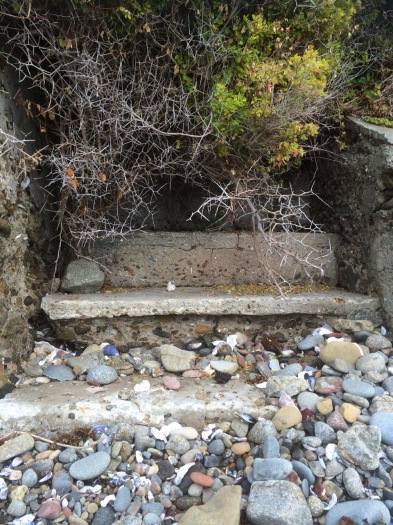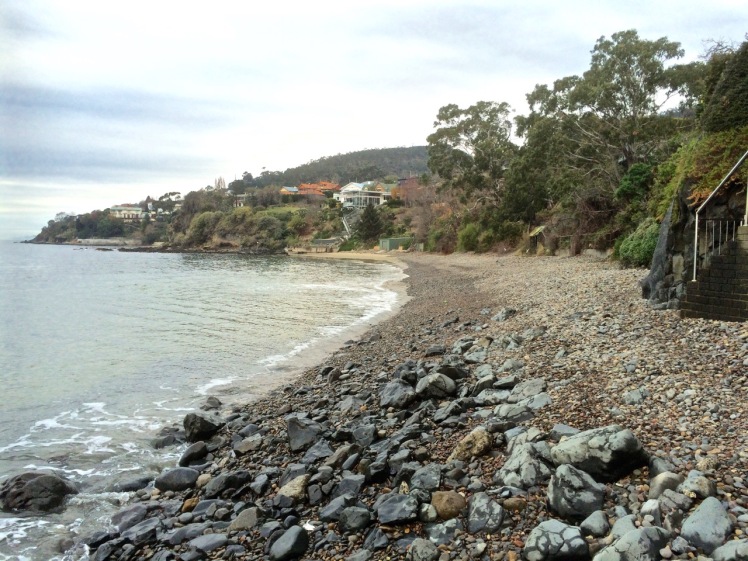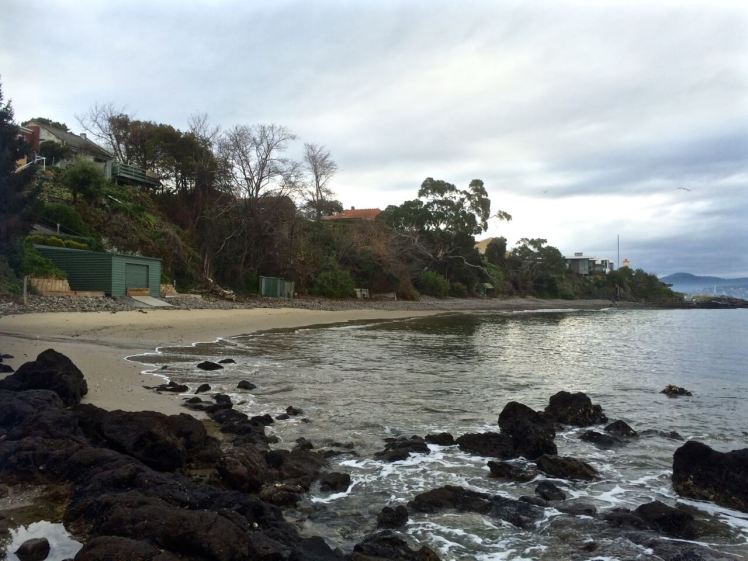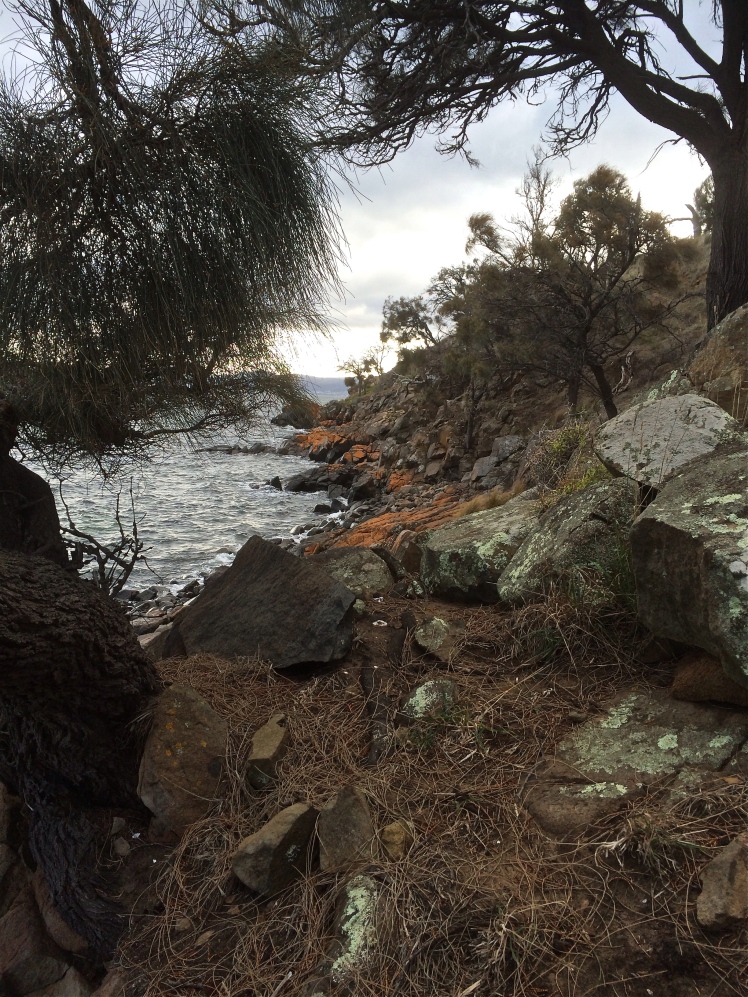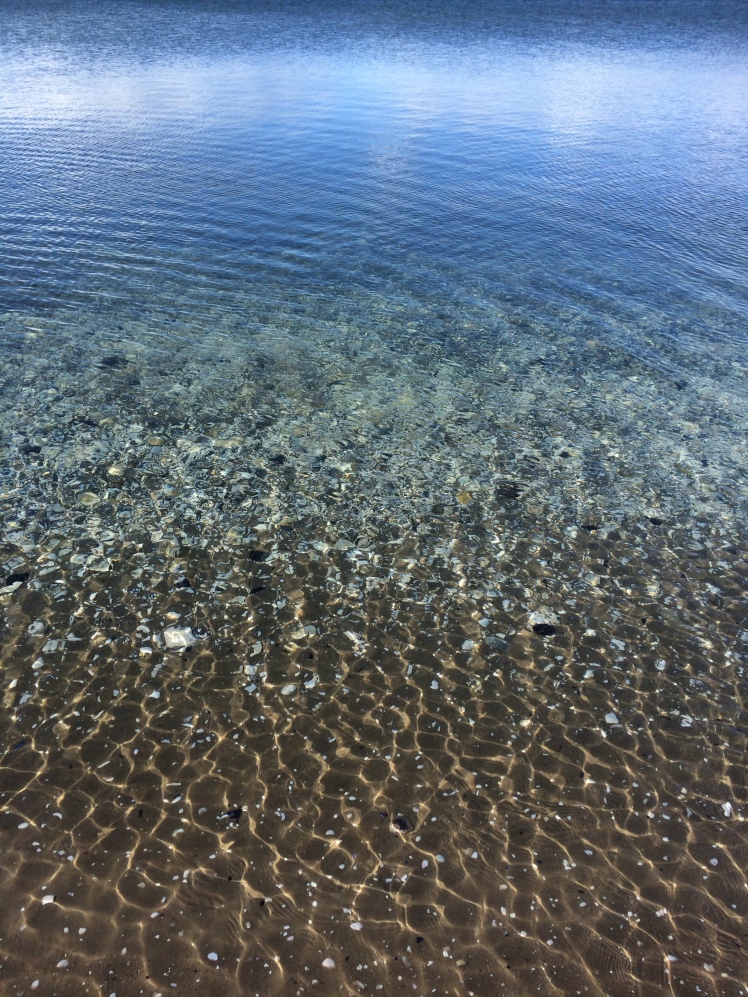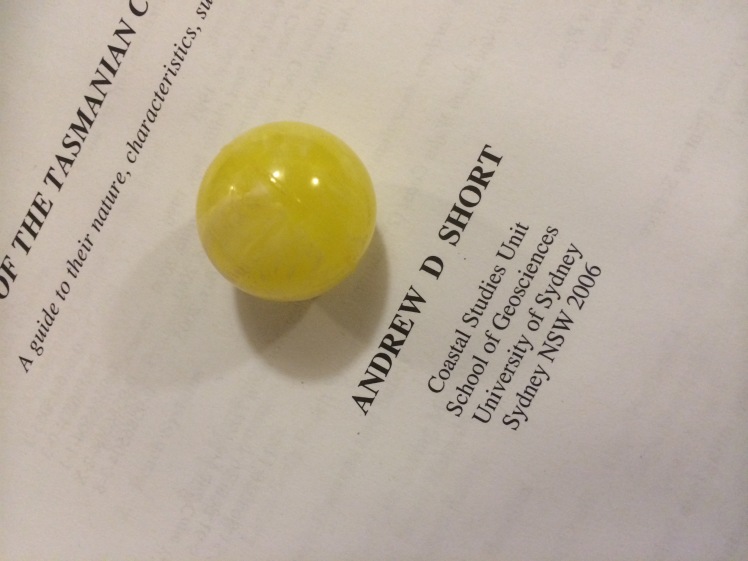Derwent River: South Arm Beaches – A two cape walk
Looking for Deliverance, Direction and Hope

No Place Safe Enough
South Arm is Calvert country. The name is everywhere and at the eastern entrance to the river the Calverts once had fruit orchards on a farm called Pleasant View. In September 1939 they sold it to the army and in 1944 the army built Fort Direction. The military base extends across both Cape Deliverance and Cape Direction.
Even down at the bottom of the world, the idea of falling to the enemy made people jumpy. That’s why, from 1804, shortly after the colony was established and on into WWII, a network of batteries and bunkers was built down both shores of the Derwent to where in Storm Bay the river merges with the Southern Ocean. Standing right at the river’s mouth, Fort Direction and the Pierson’s Point battery were the first line of defence against enemies arriving by way of the Southern Ocean (Tasmanian Times, 25 Feb 2011).
Seacroft Bay and Fort Beach
On one of summer’s more perfect days, Cathy and I set off on a walk along Fort Beach, Seacroft Bay’s only beach. It was low tide and our ambition was to walk across both capes and on to Hope Beach. But the army had not responded to my request for permission to traverse military land and we anticipated that our walk would be a brief one that would end abruptly where the beach gave way to military land.
The low dunes backing the beach are infested with marram grass and the river had been nibbling away at them. Blessington Street runs behind them and the houses here enjoy superb views over the estuary. We chose to walk along the swash, stopping to consider an outcrop of rock emerging from the sand and remarking to each other that we had finally reached the last beach on the Derwent River’s eastern shore.
There was a woman with a dog quite a distance ahead of us. Beyond her a man took a path up from the beach and disappeared into the bush on to what had to be military land. If he’d gone that way then so would we.
The dog owner had stripped down to her bathers and was about to plunge into the perfectly transparent water by the time we reached her. We got chatting and she told us it was possible to continue on via the rocks, or alternatively by way of the path the man had taken. We quickly decided that the rocks would be more adventurous and walked on, undeterred by the sign we saw on the beach.

Passing four pied oyster catchers, I wondered about the impact of toxic waste on the birds who call by and unwittingly spread toxicity further afield and on those birds who make their summer residence here and possibly bury into it.
Cape Deliverance
The rocky platform at the base of Cape Deliverance was beautiful, the pools rich with kelp and seaweed. It was tessellated in places and there were dropstones and small formations that the geo later suggested were probably remnants of an earlier rock platform.
Soon we came to the kind of risky gulch that has you wishing you’d remembered to bring a first aid kit along, just in case. A little later we walked around a point and were elated to see the Iron Pot lighthouse right ahead of us, at the end of the low lying reef.

Pot Bay
This was not the only surprise. In Pot Bay, tucked between the two capes, there was another beach. While Fort Beach gives every impression of being the last beach, this secret beach appeared to hold that honour. Obviously I hadn’t been too observant when sailing passed this area, perhaps because it’s not possible to sail between the capes and the Iron Pot. There’s that dodgy reef and sometimes there are cray pots off it, so it pays to have ample sea room.
Marram grass hadn’t made as much of an inroad on this beach’s dunes. Native vegetation still owned them. Cathy pointed out that we were not the first to have visited that day. There were footprints: human, dog and bird.
Tucked away beside the dunes we found a structure made from driftwood and plastic debris and after enjoying it we carried on walking along this largely litter free beach.
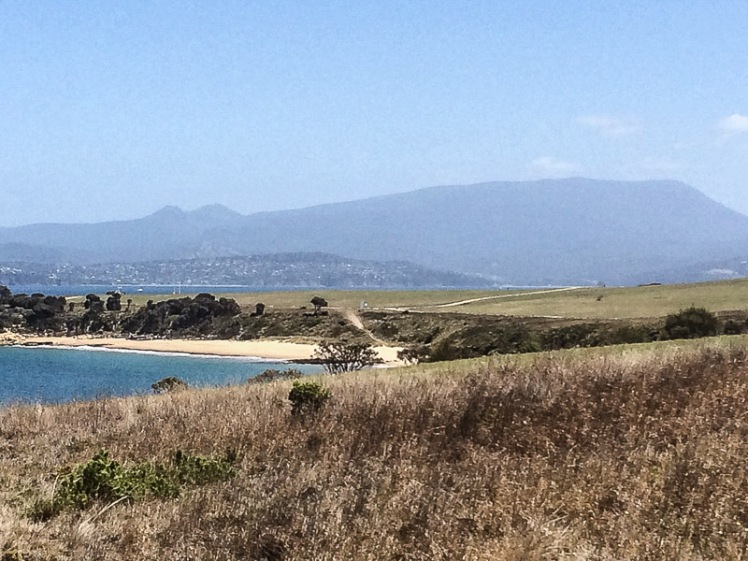
The Last Beach on the Derwent
Beyond Pots Beach we found another, even smaller beach (T 414, Short 2006). Although little more than a 80 m cove below Cape Direction, it is the beach that actually has the honour of being the last beach on either side of the river.

Tackling Cape Direction
That small beach was so protected we couldn’t get all the way around the rocks because of a fairly dramatic drop off and so we decided to do like mountain goats and scramble up the cliff. I was still picking my path upwards when Cathy disappeared from view. Although I was sure I’d have heard her if she’d fallen over the edge, I tried peering over the edge to make sure she wasn’t spreadeagled on the rocks below. I called her once and then I called her again, this time a whole lot louder.
She appeared above me and said she’d found a path. Trusting that no snakes were sunbaking in this vicinity, we made our way through tall grass and scrub to a path that led around the headland, taking cover when we noticed a Toyota 4×4 heading towards us. Behind us, and way up on Fort Hill, there are Defence Dept buildings and houses. The Toyota must have seen us but as no one accosted us we continued on our way.
Ahead we could see signs and a small concrete building. Later I read that:
‘The naval command [lived] on the hill at Fort Direction. These men had to carry out watch over the entrance to the harbour. A small weather board building of four rooms was constructed on the top of the hill with the adjacent flag pole for the raising of signal flags. A watch was maintained 24 hours a day from 1940 – 1945. As many as fifteen naval personnel lived in quarters just below the top of the hill.’ (Potter, RSL website)
The signs warned about asbestos in this vicinity but beyond them there were cliff top views to die for, so as a vague protection I held my phone in front of my nose. The sea breeze hadn’t yet roused itself and we figured any asbestos left on the surface was dormant today and must surely have been blown far and wide by now, or was beneath ground lining shearwater burrows. It was easier to simply not think about the other nasty chemicals we might be exposing ourselves too but instead to focus on the quite dramatic views of the Iron Pot and Bruny Island from this high vantage point. They were heady, and so we lingered.
As we searched around for an onward path we discovered that there were middens up and a steeply plunging cliff face on the north eastern side with a pebbled cove beneath it. We could now see all the way along the cliff line to Hope Beach. Hope looked so close yet so unattainable.
Headlands are tricky for walkers because the way can be barred by private land, but being military land we didn’t want to find ourselves in the middle of an explosives test. There were fences and box thorn and no doubt moon bird burrows, and although it was conceivable we might find a way, we decided on balance that we would turn back. I wondered about kayaking the capes and then I remembered one particular time I’d sailed them.

The Capes by Sea
The fleet stretched out ahead of us one balmy Saturday on the return leg of a long distance race around Betsey Island. We were towards the back of the fleet, the conditions favouring lighter yachts and we were sailing excitingly close to the surf break off Hope Beach.
We were off Cape Direction when we observed that the boats out ahead of us had heeled dramatically. The big blue Beneteau liked rough weather. When lighter yachts heeled, she’d barely lean, but this southwesterly was intent on causing havoc. Much earlier in the day the frustration had been a long period becalmed while the rest of the fleet sailed a sneaky breeze.
We hadn’t even considered reefing before the wind whammed into us and the yacht heeled like I’d never experienced her heel before. Suddenly the cliffs and the Iron Pot, on what was now a lee shore, seemed exceedingly close and the normally laid back crew leapt into action with alacrity. There was a cacophony of yells to ‘down traveller!’ ‘main out!’ and ‘reef!’ And where there were usually one pair of hands on a line there was now the urgency of many, some at cross-purposes.
As we made it around both capes and the Iron Pot with sufficient sea room to keep us safe, the wind swung behind us, the crew grew animated with unanticipated hope and the yacht, now sailing in far more favourable conditions, began to power up steadily through the fleet.

Making Like a Ghost
Cathy and I turned back (but If you’re planning to walk further than us then see below for a couple of tips.)
This time we took the path that ran along the cliff top passed the shearwater colonies and in so doing bypassed the Lone Pine Memorial where a dawn service is held each ANZAC Day. At various points we tried short cuts but we didn’t want to damage burrows and the hollows behind the dunes roared ‘Snakes!’ at us and so we kept out.
There was something quite old time about taking the neat path we found over a fully mown hill as though we were on a clear road to somewhere, like walkers between villages in the olden days. The sweep up Fort Hill was devoid of people until we crested a rise and saw not very far away from us the same white Toyoto we’d seen earlier. Three people were bent over, working silently at some incomprehensible task, apparently just as eager to ignore us, while we, trying to avoid them, searched again (but more frantically) for a short cut off military land and on to the beach.
They were only about 10 metres away from us anyway, and we were beginning to feeling foolish. Tired of feeling like ghosts we called out, ‘are you conservation volunteers?’
‘Army,’ they said, avoiding eye contact, and turned back to fencing a tiny tree (a lone pine?) behind a small monument while we stood about a metre away photographing the little memorial in front of the tree with its engraving of the Dardenelles. Then, feeling as though we had transformed into ghosts again, we carried on down the path back on to Pot Bay Beach.
Au revoir, timtumili minanya
We had stood at the mouth of the Derwent (known before settlement as timtumili minanya to at least some of those living along its banks). Ocean beaches and headlands stretched out to the east. Our walk had included two capes and and had taken us from the river to the meeting place on the eastern shore of the Derwent River, Frederick Henry Bay and Storm Bay with three of the Betsey Island group of islands – Betsey, Little Betsey (hidden from our vantage points) and the Iron Pot just off shore. From this point on we’d be walking ocean beaches all the way to the mouth of Pittwater Lagoon, but we thought we might just have a go at seeing if we could walk Cape Direction from the Hope Beach side.
~~~
Tips: If you don’t want to sail or kayak the capes, you can actually walk all the way around to Hope Beach. According to Greg Faull’s blog post it’s possible. The Pandani Walking Club website also discusses this option but indicates that it can be precarious:
‘Thu 17 Aug South Arm to Cape Direction Grade: Easy Map reference: Blackmans Bay 1:25k Book by: 8:00pm Wed 16 Aug Start at: 10:45am at car park opposite South Arm War Memorial Group limit: 20 Bring: The usual daywalk gear This is an easy walk from South Arm to Cape Direction opposite the Iron Pot Lighthouse along a newly made track and the fore shore. We will do it `out and back` rather than as a circuit, avoiding the steep box thorn and mutton bird burrow ridden climb up from the western end of Hope Beach and precarious cliff top walk to the cape. It is an easy 4 hour walk with time for coffee at `The Sand Bar` on the way home. There are magnificent panoramic views, especially from the cape.’
* This is an Aboriginal name for the Derwent River, found in the Tasmanian Aboriginal gallery at the Tasmanian Museum and Art Gallery. Interestingly, the spelling for the people living along the western shore is given as Muwinina, which is different to the spelling I’ve found in other sources.


































